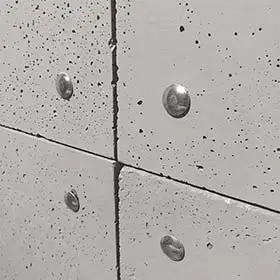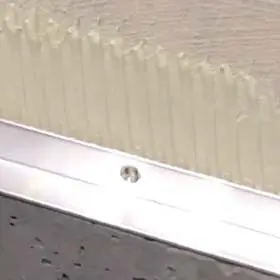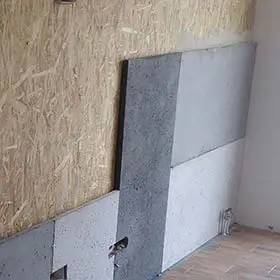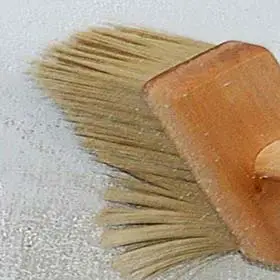If you stick to the rules, the installation of architectural concrete panels is very simple, although of course it is best to entrust it to specialists.
Remember, too, that when you store the slabs after unloading, always place them as vertically as possible on the long edge and preferably with the texture facing forward (to eliminate the possibility of confusion during installation).
1. Before installation, unfold the boards to match any shades and porosity and check for defects. Before gluing, the slabs should be dry and without defects.
Concrete slabs may deviate from the dimensions specified by the manufacturer by 0.9%.
With large-size slabs, there may be an effect of the so-called swelling of up to 5 mm.
When joining floor slabs, platforms, there may be differences in levels up to about 5mm. When joining boards with development elements that do not hold dimensions / angles, gaps of 50-200mm may occur.
2. on walls covered with plaster, paint, gypsum plaster, etc. make sure that the boards will have adequate adhesion. It is recommended to use a grafting primer with quartz sand admixture. If in doubt, use one of the mechanical fixings or mount an OSB board on the wall.

a) Mounting visible - round decorative anchors.

b) Invisible fixing - SecretAlu mechanical strip. SecretAlu.

3. When installing architectural concrete on OSB, it should be anchored to the wall.

4. Before installation, the surface to which the panels will be glued should be primed with a grafting primer with quartz sand. In some cases, it is recommended to use a contact layer for difficult surfaces.
5. Before gluing, check that the glue does not damage the board, that is, stick the board and wait for the glue to dry, in order to check for discoloration, damage.
6. You can cut, drill and make holes in Modern Concrete concrete slabs at will. Use stone tools. Drill the slabs without impact.
7. Installation with polymer glue. The glue should be applied with a dense mass extrusion gun, in parallel vertical strips across the width of the board every 20-25 cm. If you use a glue other than that indicated by us, complaints will not be accepted.
However, when you use an adhesive other than the one recommended by us, lay one board and make sure that the adhesion is sufficient and that the boards do not deform. In addition, to avoid absorption of water from the glue, you should prime the boards on the glued side at least 24 hours before installation.
If you get the board dirty with glue or grout, you must remove it immediately!
8. The panels should be assembled taking into account the grout ( expansion joints ) at intervals of at least 3-5 mm.
9. 24h before installation, it is recommended to prime the back of the board ( the surface to be glued to the wall) and the wall itself with a grafting primer with quartz sand admixture.
10. After installing the panels, we recommend using an impregnant from the Modern Concrete range, the only one recommended for our panels.
11. Before impregnation, the boards must be cleaned of all dust and sediment. If you have any objections to the appearance of the board immediately contact us before impregnation.
12. When impregnating floor boards, wait 24-36 h after impregnation before using them.
FOR DETAILED INFORMATION ON THE CHARACTERISTICS OF THE ARCHITECTURAL CONCRETE PRODUCT, PLEASE VISIT THE LINK:
https://www.modernconcrete.pl/karta-produktu/
BELOW ALSO A LINK TO THE RULES AND REGULATIONS OF OUR COMPANY:
Installing architectural concrete for an amateur can be quite a challenge, but by applying a few rules you can manage it. First of all, before you start installing concrete panels on the wall, make sure that the wall on which the panels are to hang is strong - a square meter of concrete can weigh up to 40 kg. A wall covered with plaster or gypsum plaster is not suitable for gluing architectural concrete panels. Before installation, they should be properly prepared by incising the wall in the places where the adhesive joins the wall ( in order to bind the adhesive to the substrate under the gypsum plaster) or installation without interfering with the substrate by using mechanical fixings. The most important thing in laying concrete is to use a joint (expansion joint) of at least 3-5 mm and to maintain the correct level, so a level will be a very useful tool. The slabs can be cut to any size and holes can be drilled in them. For trimming, use stone tools, not tile tools - this way you can be sure that the slabs will not break. Drill the slabs without a hammer.


There are two basic types of mounting - visible and invisible. The first involves the installation of special anchors (locking screws), on which the panels are hung - so you can see the mounting elements on the concrete, which is an additional decoration. The second solution is to glue the concrete to the wall. In this case, use polymer glue. The glue should be applied with a dense mass extrusion gun, in parallel vertical strips across the width of the slabs every 20-25 cm. This guarantees the correct positioning of the boards and ensures their strength. After the installation, it is necessary to properly impregnate the architectural concrete, so that the wall will retain a long life.
Installation of architectural concrete panels is not an easy task. If you are not sure of your skills or do not have the necessary equipment, it is better to entrust the installation of architectural concrete to professionals. Contrary to appearances, such a solution can save you a lot of money. First of all, you will be sure that no slab will break and that it will fit perfectly into your interior. And most importantly, professional installation of concrete slabs on the wall and subsequent impregnation of architectural concrete will make the concrete wall durable, and you will enjoy it for many years.
By purchasing our products, you confirm that you are familiar with the regulations and product sheet.